Use of Mobile Devices for Earthquake Response, Network Applications, and Diagnostics
David Slater1, Ken Smith1, Kent Lindquist2, Robert L. Newman3, Carol Freinkel1, John Torrisi1, and Glenn Biasi1
INTRODUCTION
Mobile, hand-held electronic devices such as Internet-enabled cell phones, personal digital assistants (PDAs), and similar tools are vastly expanding the potential to bring sophisticated Internet-based communications to a broader pool of users and workers than the traditional, wired Internet. In particular, such cellular devices are making possible a host of new mechanisms for remote interaction with seismic network hardware, seismic waveform data, and real-time seismic software systems in areas with reliable coverage. Many seismic network diagnostics and interactive processes can be extended to mobile devices, eliminating the need for personnel to be tethered to laptops and hard-wired Internet connections. With a properly written set of mobile-device applications, seismic networks can now provide their staffs with practical, 24–hour-a-day, seven-day-a-week access to network diagnostic tools and configuration tools and provide seismic-network information products to their staffs and constituents.
To demonstrate the utility of mobile devices to seismic networks, we have written a suite of nine mobile-device applications, placed them in use for the Nevada Seismological Laboratory (NSL), and released their source code to the public. These applications assist in remote monitoring and reconfiguration of NSL real-time network operations; remote review and approval of information products for release; and widespread distribution of real-time results via Web-enabled mobile devices. We have used the server-side Web-scripting language PHP 9PHP 20080 to construct these programs. Two of these programs facilitate interaction with the U.S. Geological Survey’s ShakeMap program (Wald et al. 2005); three programs facilitate interaction with real-time systems and databases of the Antelope Environmental Monitoring System (BRTT 2008) via the Antelope interface to PHP (Lindquist et al. 2005); and the remaining four programs help manage Ref Tek RT130 data loggers (Ref Tek 2008), Motorola “Canopy” Internet-Protocol (IP) radios (Motorola 2008), seismic-station maintenance logs, and sensor calibration procedures.
The NSL network staff routinely uses these mobile applications in earthquake response and in field operations. As an aside, these development efforts have also helped the authors address the needs of the Advanced National Seismic System (ANSS; USGS 1999) performance standards and to support the needs of earthquake first responders through ShakeMap and other response criteria.
Design Considerations for Mobile Applications
Mobile devices are limited in output by small physical screen sizes and low resolutions; they are limited in input by small keypads and single-handed operation modes; and they are limited in bandwidth by cellular network protocols and provider coverage. These constraints limit options when creating mobile applications, thus requiring more stringent design work than for desktop applications.
Standard good practices for graphical user interface (GUI) design are thus markedly more important for mobile applications. In the early stages of application design, user interactions should be laid out in “story-board” drawings to evaluate interaction concepts. Application prototypes for the front-end GUI need to be developed and tested before extensive back-end (data processing) coding is done. Prototypes need to be tested thoroughly on various mobile devices for smooth user interaction and optimal screen layout.
Because text entry can be slow and display areas limited, the applications must be designed to simplify user choices and interaction. Type-in URLs, sorting, and subsetting options are best replaced wherever possible with interactive GUI elements such as radio buttons and multiple-choice lists. Furthermore, a single wrapper program helps to centralize access to all the resources.
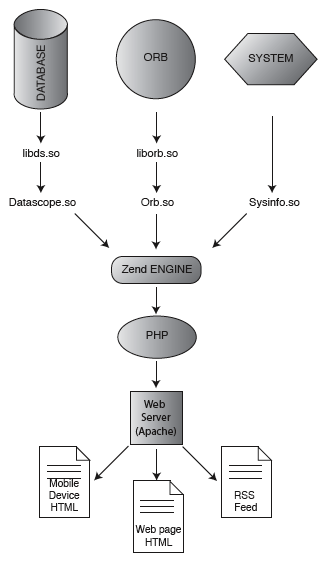
▲ Figure 1. Schematic of the underlying software layers. Data are retrieved from Datascope databases and Antelope orbservers by the Antelope libds.so and liborb.so shared-object libraries, respectively. These native Antelope libraries are linked to the PHP interpreter by the new Datascope.so and Orb.so PHP extension libraries, allowing data to be displayed on Web pages using PHP code embedded in HTML. A parallel sysinfo.so extension library provides access to a number of Antelope system-information utilities. Reproduced with permission from Lindquist et al. 2007.
The Antelope Interface to PHP
The three Antelope-specific mobile applications are built on the Antelope interface to PHP, a set of tools for interacting with real-time Antelope orbservers and Datascope databases from the Antelope real-time system (BRTT 2008). (The Antelope interface to PHP is freely available through the Antelope contributed-code Website at http://www.indiana.edu/~aug). The Antelope interface to PHP consists of the Datascope, ORB, and Sysinfo shared-object extensions (figure 1). This diagram shows the Antelope PHP extensions in their system context. Three shared-object libraries are implemented that make core elements of the Antelope Application Programmer Interface available in PHP. The Datascope.so library provides access to Datascope databases; the Orb.so library provides access to packet objects and their contents on an Antelope orbserver; and the Sysinfo.so library connects to a variety of Antelopebased system-information tools. As shown in figure 1, an Antelope real-time system manages a variety of orbservers and databases. Dynamic Web pages can be created that reference these resources, accessed through an Apache (Apache 2008) Web-server that employs mod_php to invoke PHP scripts that exercise the Antelope functions (Lindquist et al. 2007).
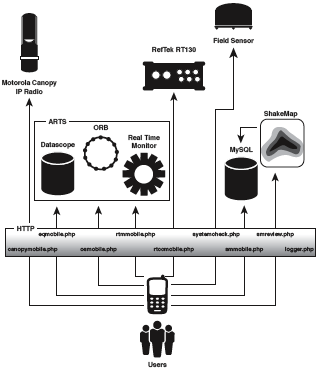
▲ Figure 2. Schematic figure of the various mobile Web applications accessible online, and which components of the real-time monitoring system they are associated with.
NETWORK APPLICATIONS FOR MOBILE DEVICES
The mobile applications developed in the current work are listed in table 1 and shown schematically in figure 2. Uniform resource locators (URLs) are provided for output examples from those applications that are available for public view. While the source code for all applications is available as described below, URLs with output examples are available only for those programs for which public access is appropriate. Applications that allow privileged operations, such as datalogger, telemetry system, and database changes, are password-protected and do not have publicly visible examples.
ShakeMap Mobile (smmobile.php)
ShakeMap Mobile provides public access to ShakeMaps on handheld devices. ShakeMap Mobile has been optimized to display ShakeMap events on the limited screen size afforded by mobile Web browsers, as shown in figure 3. Selecting the desired event is done by dynamically querying the ShakeMap (MySQL 2008) database and selecting from all ShakeMap events, subsetting on particular years or only displaying ShakeMap scenarios. (NSL uses the Antelope “dbpick” function to generate waveform images. Users can implement any image display link; Antelope is not required.) The application allows sorting of the displayed events by magnitude, event ID, latitude, or longitude.
| Script | Application Name | Purpose | Software Dependencies | URL with Sample Output |
|---|---|---|---|---|
| smmobile.php | ShakeMap Mobile | Interface to ShakeMap output and archives | ShakeMap | http://seismobile.seismo.unr.edu:8090/smmobile.php |
| smreview.php | ShakeMap Review | Review and rerun ShakeMap, mark as “reviewed” | ShakeMap | |
| eqmobile.php | EQ Mobile | Access to Datascope database tables | Antelope | http://seismobile.seismo.unr.edu:8090/eqmobile.php |
| osmobile.php | Orbstat Mobile | Status of an Antelope ORB | Antelope | http://seismobile.seismo.unr.edu:8090/osmobile.php |
| rtmmobile.php | RTM Mobile | Check, start, and stop Antelope rtexec processes | Antelope | |
| rtccmobile.php | RTCC Mobile | Administer RefTek RT130 data loggers | Reftek RTCC | |
| canopymobile.php | Canopy IP Radio Mobile | Manage Canopy IP radios | ||
| logger.php | Mobile Maintenance Logging | |||
| systemcheck.php | Field Sensor Calibration | Initiate and review sensor calibrations |
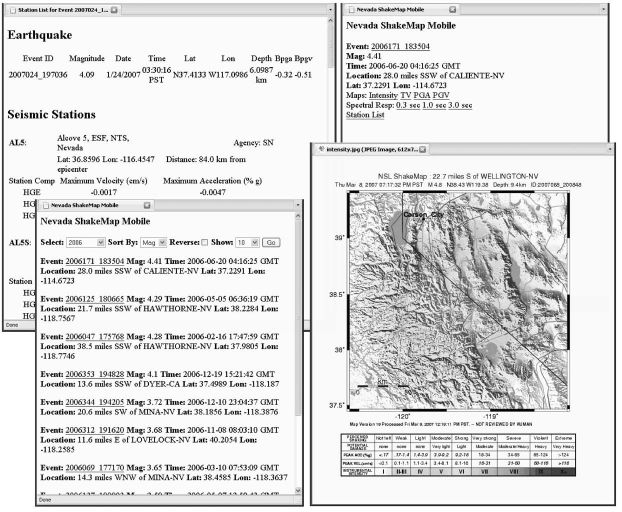
▲ Figure 3. ShakeMap Mobile home screen (lower left) allows the mobile device user to display and select ShakeMap events of interest using drop-down menus. Once the event is selected, other detailed ShakeMap screens can be accessed such as the event summary, seismic station information, and graphical intensity map.
ShakeMap Review (smreview.php)
ShakeMap Review is a secure application for confirming/reviewing ShakeMap results from the handheld device. This application was driven by the need to meet ANSS response criteria as well as addressing the need for 24/7 response. In principle, it establishes a 24/7 monitoring mechanism for interaction with ShakeMap; subsequent access to smreview.php will note whether events have been reviewed. This mobile program lets staff examine the waveforms for the event, view the individual station ground motions for outliers, rerun ShakeMaps, mark them as reviewed, and delete them if need be through the interactive menu (figure 4). Actions are selected from a radio button list.
EQ Mobile (eqmobile.php)
The example in figure 5 shows how the Datascope.so PHP library functions provide easy access to Antelope Datascope database tables. EQ Mobile queries the Datascope origin table and provides selection criteria, sorting, and other functions. Selecting an event shows detailed information for the entire origin table row for that event. Links to other applications such as ShakeMap Mobile can be readily displayed for the selected event. The application is easily extended for more comprehensive database actions, e.g., join, subset, and query.
Orbstat Mobile (osmobile.php)
The example in figure 6 shows how Orb.so PHP libraries provide access to data in an Antelope ORB. Orbstat Mobile allows one to select an ORB, networks, and/or stations to query. Channel latencies and data rates are displayed for the selected criteria showing relevant information from an “orbstat” query. Field staff can independently confirm that data has been received within the data processing system following station maintenance.
RTM Mobile (rtmmobile.php)
System operators can control the functions of all Antelope real-time processes with the real-time monitor (RTM) Mobile application, as shown in figure 7. One first selects the Antelope real-time system instance from a drop-down list. From there, one can start/stop processes, query Antelope configuration files (parameter files,.pf ), and generally confirm process status. Also, one can check the tasks to make sure they are running properly and also start, stop, or restart a task as needed.
RTCC Mobile (rtccmobile.php)
Reftek RT130 Data Loggers can be administered using the Reftek-supplied Web application RTCC. (RT130 and RTCC are products of Refraction Technology, Inc., http://www.reftek.com.) The mobile interface to RTCC shown in figure 8 is optimized for mobile devices and allows technicians to perform basic RTCC tasks: clear RAM (random access memory), format flash disks, or reset the data acquisition system (DAS). In addition, RTCC Mobile allows for a large-packet ping test to verify network telemetry and a means to verify that the data for the station is actually arriving into the acquisition ORB at the network data center.
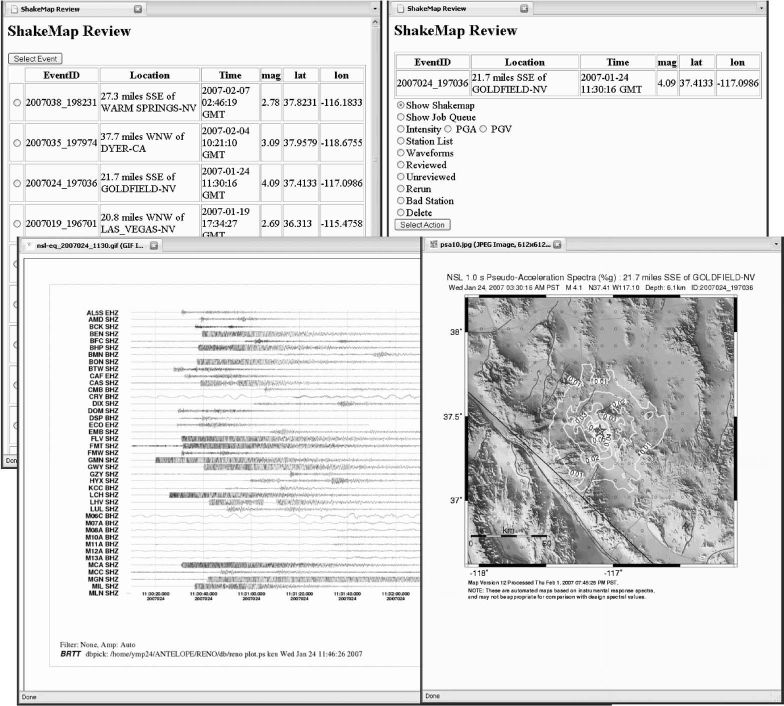
▲ Figure 4. ShakeMap Review home page (upper left) shows the most recent ShakeMap events, which can be selected for review actions by ShakeMap administrators. The lower left screen shows an example of waveforms for a selected event.
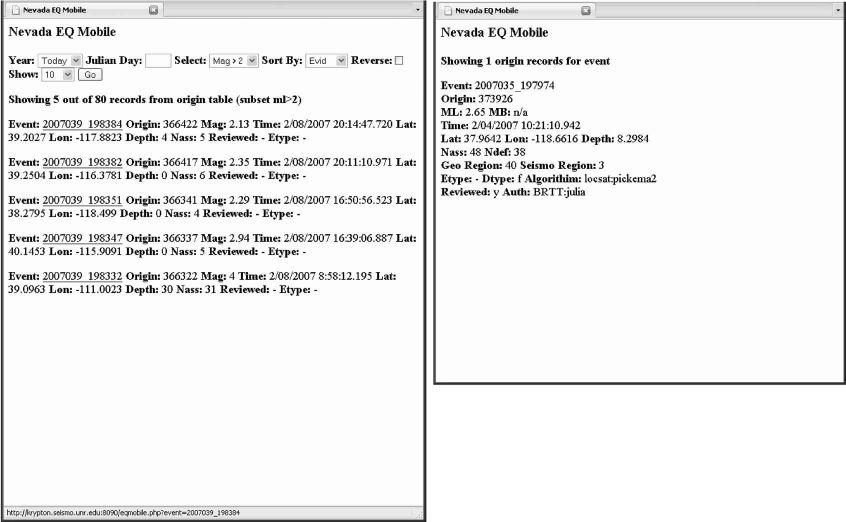
▲ Figure 5. EQ Mobile showing an interactive summarized view of the Datascope origin table. Selecting an event shows a detailed screen for a single event.
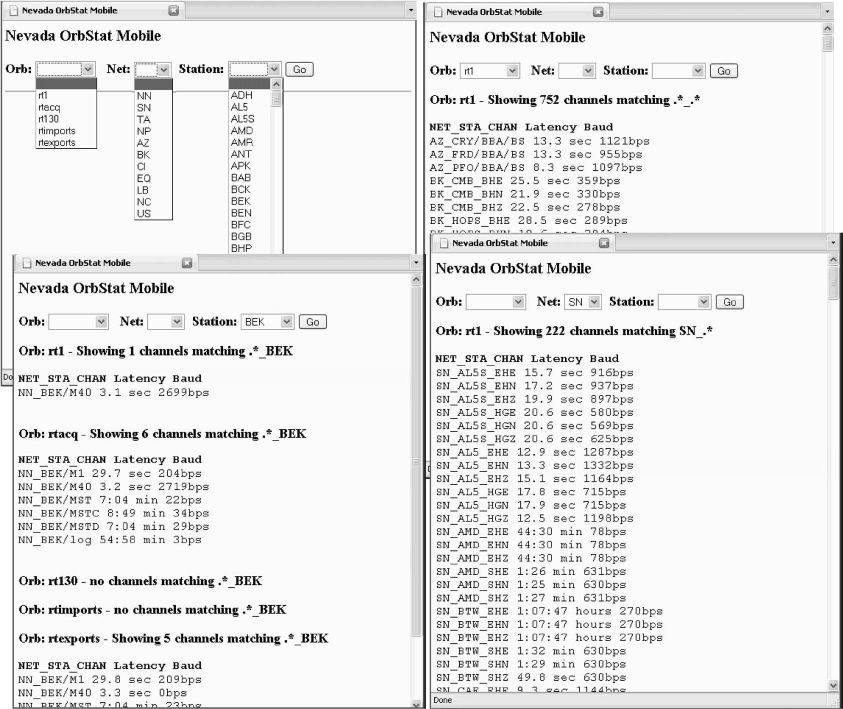
▲ Figure 6. Orbstat Mobile home screen (upper left) allows the mobile user to display ORB information by a specific ORB, network prefix, or station name. Other screens show results of the various types of queries that can be made.
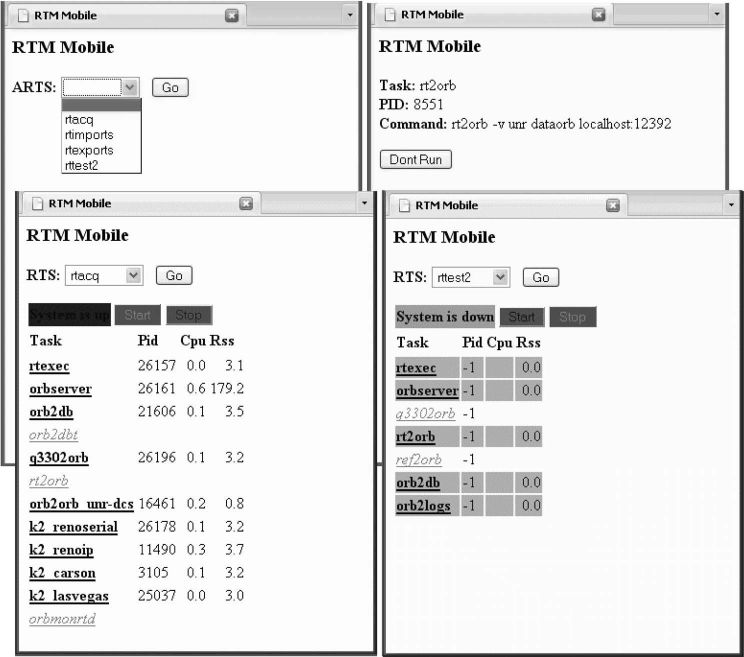
▲ Figure 7. RTM Mobile allows control of an Antelope Real-Time System (ARTS) from a mobile device.
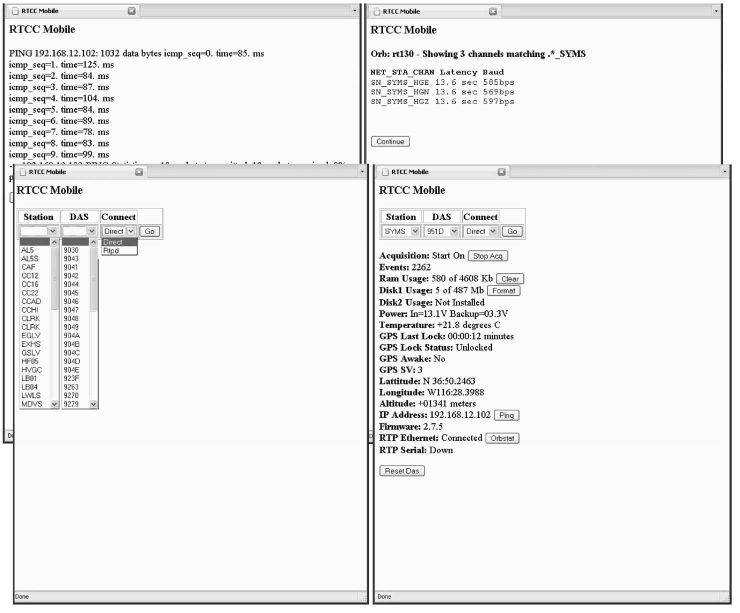
▲ Figure 8. RTCC Mobile home screen (lower left) allows DAS election and displays the DAS detail screen (lower right) where the DAS control actions can be initiated.
Canopy IP Radio Mobile (canopymobile.php)
Canopy Internet protocol (IP) point-to-multipoint and backhaul radios are easy to manage and provide cost-effective telemetry to many seismic stations in the NSL network (the Canopy IP radios are a product of Motorola, http://motorola.canopywireless.com/). The status of Canopy IP radios can be checked using the secure application canopymobile.php, as shown in figure 9. Radios can be selected from a drop-down list, and status, sessions or other configuration can be displayed. Technical staff with cellular access can query all Canopy radios in the network. This application has been particularly useful in diagnosing radio status during implementation of IP communications for the seismic network in the Nevada Test Site region.
Mobile Maintenance Logging (logger.php)
The Mobile Maintenance Logger provides the ability to log information during site visits and station maintenance. Specific stations can be selected from a drop-down list, and text entries can then be logged via e‑mail and a status log file. For any site maintenance activity, e‑mails are sent internally to relevant staff to ensure that everyone is aware of ongoing network activities. The file maintenance logs can be incorporated in a relational database for more rigorous organization for network field activities.
Field Sensor Calibration (systemcheck.php)
The system check application shown in figure 10 allows remote access to the central data center Datascope database for initiating velocity sensor calibrations for RT130 dataloggers (Ref Tek RTCC control function) and for confirming instrument response parameters. Field technicians can review sensor calibration results (sensor free period and damping) and pulseshape waveforms and then initiate printouts of field documentation at the data center, independent of data center staff interaction. This application creates a central point-of-control for conducting system checks, confirming system check output, and eliminating a number of steps in formal operations procedures while at the same time improving confidence in managing seismometer response. System checks can be run at any time from any location; in particular, questions regarding instrument response parameters during analysis of current event activity can be quickly confirmed if necessary. The application can be easily extended to other system check and calibration applications
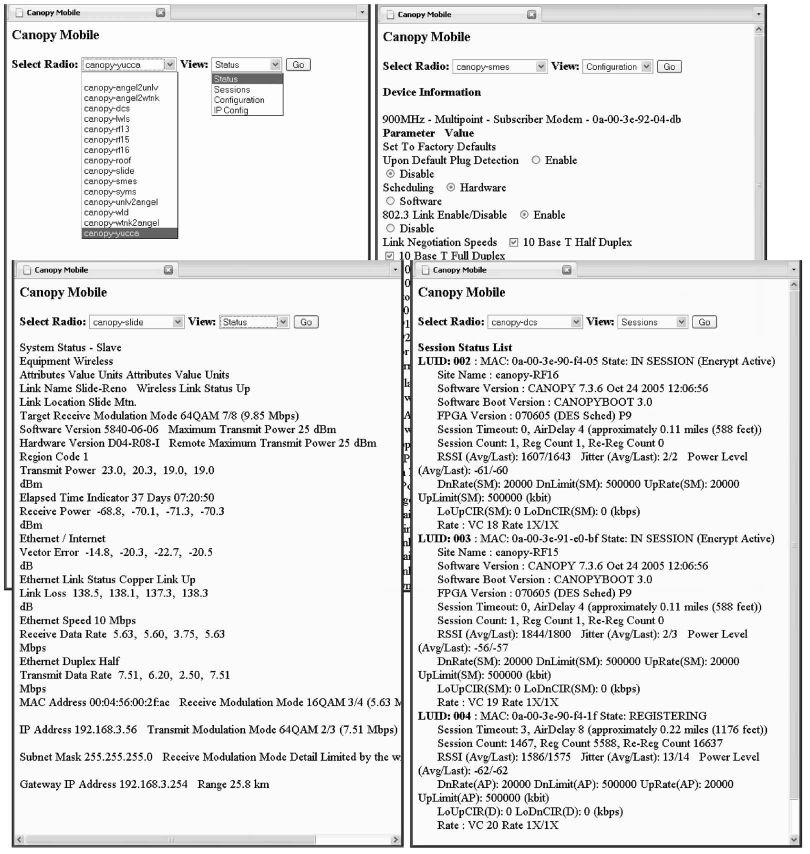
▲ Figure 9. Canopy IP Radio Mobile home screen (upper left) allow selection of the Canopy radio device to query. The other screens show the various detailed device pages for the Canopy radios.
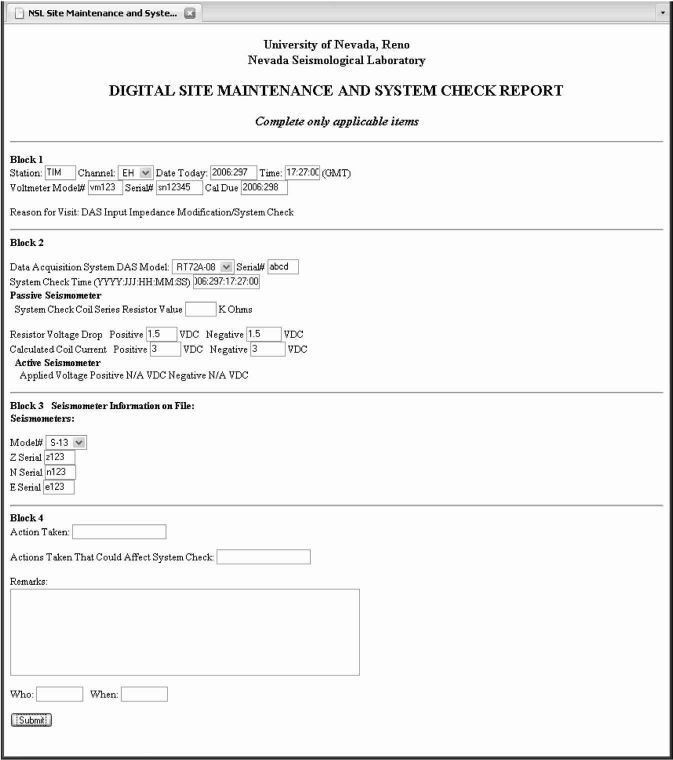
▲ Figure 10. Field Sensor Calibration (System Check).
USE OF MOBILE DEVICE APPLICATIONS IN THE M 6.0 WELLS, NEVADA, EARTHQUAKE FIELD DEPLOYMENT
In the field response to the 21 February 2008, M 6.0 Wells, Nevada, earthquake, the NSL and the U.S. Geological Survey deployed a network of eight Ref Tek RT130 dataloggers that are telemetered via Motorola Canopy IP radios to a State of Nevada Department of Information Technology microwave site outside the city of Wells. The real-time data is managed at the NSL datacenter. With local cell access in the Wells area along the I-80 corridor, the mobile device applications described here are being used to maintain the remote communications system and dataloggers. Rtccmobile.php and canopymobile.php provide a complete view of all radio and datalogger status from remote field locations and for NSL staff in Reno, Nevada.
SOURCE CODE AVAILABILITY
The PHP source code for all nine applications described herein is freely available for download at http://www.seismo.unr.edu/seismobile. Networks wishing to run these codes would need the source-code package above, an installed PHP interpreter, and a compatible Web server (for example Apache). In addition, for the ShakeMap-dependent scripts they would need ShakeMap, for the Antelope-dependent scripts they would need an installed copy of Antelope, and they would need the proprietary Reftek and Motorola interfaces for support of those instruments. The authors intend to maintain these applications for the general community and periodically post updates to the source-code distribution above. ![]()
ACKNOWLEDGMENTS
This research was supported by the Department of Energy Nevada System of Higher Education Cooperative Agreement DE-FC28-04RW12232 for the Yucca Mountain Project and the United States Geological Survey Western Great Basin Seismic Network Operation Cooperative Agreements 07HQGRAG0015 and 04HQAG0004.
REFERENCES
Apache (2008). The Apache Software Foundation. http://www.apache.org. Last accessed May 10, 2008.
BRTT (2008). Boulder Real Time Technologies. http://www.brtt.com. Last accessed May 10, 2008.
Lindquist, K. G., R. L. Newman, and F. L. Vernon (2007). The Antelope interface to PHP and applications: Web-based real-time monitoring. Seismological Research Letters 78, 663–670.
Motorola (2008). Motorola Wireless Broadband Solutions. http://motorola. canopywireless.com. Last accessed 10 May 2008.
MySQL (2008). MySQL AB. http://www.mysql.com. Last accessed 10 May 2008.
PHP (2008). PHP: Hypertext Preprocessor. http://www.php.net. Last accessed 10 May 2008.
Ref Tek (2008). Ref Tek home page. http://www.reftek.com. Last accessed 10 May 2008.
USGS (1999). United States Geological Survey. An Assessment of Seismic Monitoring in the United States: Requirement for an Advanced National Seismic System. USGS Circular 1188, Version 1.0 (http://pubs.usgs.gov/circ/1999/c1188).
Wald, D. J., B. C. Worden, V. Quitoriano, and K. L. Pankow (2005). ShakeMap Manual: Technical Manual, User’s Guide, and Software Guide. USGS Open File Report, Techniques and Methods, 12-A1, Version 1.0 (http://pubs.usgs.gov/tm/2005/12A01).

